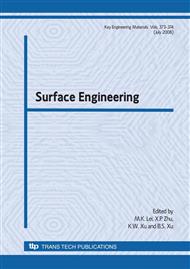p.122
p.126
p.130
p.134
p.138
p.142
p.146
p.151
p.155
The Influence of the Magnetic Field Arrangement on the Titanium Oxide Films Properties for Four Targets Closed-Filed Unbalance Magnetron Sputtering
Abstract:
The magnetic filed arrangement of unbalance magnetron sputtering can be changed employed to expand the plasma region and induce more ions to bombard the films for fabricating excellent quality films. In this paper, four targets closed-filed unbalance magnetron sputtering was introduced, the effect of the different magnetic field arrangement on the titanium oxide films properties was investigated. By changing the distance from target to vacuum center, the different unbalance state of the magnetic field was formed around the substrate. The titanium oxide films were synthesized at different unbalance state of the magnetic field. The microstructure of the titanium oxide films was studied by X-Ray Diffraction (XRD), and the residual stress measurement for the films was determined by grazing incidence XRD. The results revealed that the higher unbalance of the magnetic field around the substrate, the higher ion current of the substrate. Comparing with increasing the substrate bias voltage, the ion current increased 2~4 times through changing magnetic field arrangement to induce higher unbalance of the magnetic field. Ion/atom ratio increase was in favor of rutile phase formation for titanium oxide film. The unbalance state increase resulted in more higher compressive stress in the films.
Info:
Periodical:
Pages:
138-141
Citation:
Online since:
March 2008
Authors:
Price:
Сopyright:
© 2008 Trans Tech Publications Ltd. All Rights Reserved
Share:
Citation:


